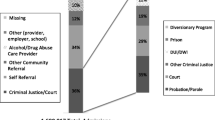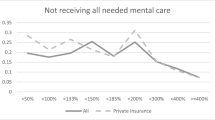Abstract
The Patient Protection and Affordable Care Act (ACA) will expand coverage of mental health and substance use disorder benefits and federal parity protections to over 60 million Americans. The key to this expansion is the essential health benefit provision in the ACA that requires coverage of mental health and substance use disorder services at parity with general medical benefits. Other ACA provisions that should improve access to treatment include requirements on network adequacy, dependent coverage up to age 26, preventive services, and prohibitions on annual and lifetime limits and preexisting exclusions. The ACA offers states flexibility in expanding Medicaid (primarily to childless adults, not generally eligible previously) to cover supportive services needed by those with significant behavioral health conditions in addition to basic benefits at parity. Through these various new requirements, the ACA in conjunction with Mental Health Parity and Addiction Equity Act (MHPAEA) will expand coverage of behavioral health care by historic proportions.
Similar content being viewed by others
References
Patient Protection and Affordable Care Act, Pub. L. 111-148, 124 Stat. 119, codified as amended at scattered sections of the Internal Revenue Code and in 42 U.S.C. (2010).
Office of the Assistant Secretary for Planning and Evaluation. The Health System Measurement Project. Available online at https://healthmeasures.aspe.hhs.gov/. Accessed May 22, 2013.
Mental Health Parity and Addiction Equity Act, Pub. L. 110-343, 122 Stat. 3765, amending 29 U.S.C. 1185a, § 712 (ERISA); 42 U.S.C. 300gg–5, § 2705 (Public Health Service Act); and I.R.C. § 9812 (Internal Revenue Code)(2008).
Banthin, J. Understanding CBO’s Medicaid Coverage Projections under the Affordable Care Act. Presentation to Academy Health Annual Research Meeting, Baltimore, MD, June 23, 2013.
Beronio K, Po R, Skopec L, et al. Affordable Care Act Will Expand Mental Health and Substance Use Disorder Benefits and Parity Protections for 62 Million Americans. February 2013. Available online at http://aspe.hhs.gov/health/reports/2013/mental/rb_mental.cfm
Banthin, J. Understanding CBO’s Medicaid Coverage Projections under the Affordable Care Act. Presentation to Academy Health Annual Research Meeting, Baltimore, MD, June 23, 2013.
Patient Protection and Affordable Care Act, §1302.
Patient Protection and Affordable Care Act, §2001(c).
Bureau of Labor Statistics. Selected Medical Benefits: A Report from the Department of Labor to the Department of Health and Human Services. April 15, 2011. Available online at http://www.bls.gov/ncs/ebs/sp/selmedbensreport.pdf.
Patient Protection and Affordable Care Act; Standards Related to Essential
Health Benefits, Actuarial Value, and Accreditation; Final Rule, 78 Fed. Reg. 12834 (amending 45 CFR Parts 147, 155, and 156) (February 25, 2013).
Center for Consumer Information and Insurance Oversight. Additional Information on Proposed State Essential Health Benefits Benchmark Plans. Available online at http://www.cms.gov/cciio/resources/data-resources/ehb.html. Accessed May 21, 2013.
National Conference of State Legislatures. Insurance Coverage for Autism. August 2012. Available online at http://www.ncsl.org/issues-research/health/autism-and-insurance-coverage-state-laws.aspx.
Patient Protection and Affordable Care Act, §1311(j).
Patient Protection and Affordable Care Act; Standards Related to Essential Health Benefits, Actuarial Value, and Accreditation; Final Rule, 78 Fed. Reg. 12834, 12867 (February 25, 2013).
Patient Protection and Affordable Care Act, §1563(c)(4).
Final Rules under the Paul Wellstone and Pete Domenici Mental Health Parity and Addiction Equity Act of 2008, 78 Fed. Reg. 68240 (November 8, 2013).
Final Rules under the Paul Wellstone and Pete Domenici Mental Health Parity and Addiction Equity Act of 2008, 78 Fed. Reg. 68240 (November 8, 2013).
Final Rules under the Paul Wellstone and Pete Domenici Mental Health Parity and Addiction Equity Act of 2008, 78 Fed. Reg. 68240 (November 8, 2013).
Skopec L, Henderson A, Todd S, et al. Essential Health Benefits: Comparing Benefits in Small Group Products and State and Federal Employee Plans. December 2011. Available online at http://aspe.hhs.gov/health/reports/2011/MarketComparison/rb.shtml.
Office of the Assistant Secretary for Planning and Evaluation. Essential Health Benefits: Individual Market Coverage. December 16, 2011. Available online at http://aspe.hhs.gov/health/reports/2011/IndividualMarket/ib.shtml.
National Conference of State Legislatures. State Laws Mandating or Regulating Mental Health Benefits. December 2012. Available online at http://www.ncsl.org/issues-research/health/mental-health-benefits-state-mandates.aspx.
Departments of Labor, Health and Human Services and Treasury. FAQs About Affordable Care Act Implementation (Part XVIII) and Mental Health Parity Implementation. January 9, 2014. Available online at http://www.dol.gov/ebsa/faqs/faq-aca18.html.
Patient Protection and Affordable Care Act, §1302(a) and (d).
Patient Protection and Affordable Care Act; Exchange Establishment Standards and Other Related Standards under the Affordable Care Act, 77 Fed. Reg 18310 (March 27, 2012) (See 45 CFR 156.225).
Center for Consumer Information and Insurance Oversight. Affordable Exchanges Guidance: Letter to Issuers on Federally-facilitated and State Partnership Exchanges. April 5th, 2013. Available online at http://www.cms.gov/CCIIO/Resources/Regulations-and-Guidance/Downloads/2014_letter_to_issuers_04052013.pdf .
Patient Protection and Affordable Care Act, § 1302(c)(1).
Final Rules under the Paul Wellstone and Pete Domenici Mental Health Parity and Addiction Equity Act of 2008, 78 Fed. Reg. 68240 (November 8, 2013).
NORC at the University of Chicago for the Office of the Assistant Secretary for Planning and Evaluation. Final Report: Consistency of Large Employer and Group Health Plan Benefits with Requirements of the Paul Wellstone and Pete Domenici Mental Health Parity and Addiction Equity Act of 2008. December 31, 2012. Available online at http://aspe.hhs.gov/daltcp/reports/2013/mhpaeAct.shtml.Or. Rev. Stat. § 743A.168 (2005).
Q&A Oregon Mental Health Parity Law for Providers. Available online at http://www.cbs.state.or.us/ins/FAQs/mental-health-parity_provider-faqs.pdf.
McConnell JK, Gast SH, Ridgely SM. Behavioral health insurance parity: does Oregon’s experience presage the national experience with the Mental Health Parity and Addiction Equity Act? American Journal of Psychiatry 2012;169(1): 31-38.
McConnell JK, Gast SH, McFarland BH. The effect of comprehensive behavioral health parity on choice of provider. Medical Care. 2012; 50:527-533.
Vt. Stat. Ann Tit. 8, § 4089b (1998).
Rosenbach M, Lake T, Young C, et al. Effects of the Vermont Mental Health and Substance Abuse Parity Law. DHHS Pub. No. SMA 03-3822, Rockville, MD: Substance Abuse and Mental Health Services Administration, 2003.
Goldman HH, Frank RG, Burnam MA, et al. Behavioral health insurance parity for federal employees. New England Journal of Medicine. 2006;354:1378-1386.
Azrin ST, Huskamp HA, Azzone V, et al. Impact of full mental health and substance abuse parity for children in the Federal Employees Health Benefits Program. Pediatrics. 2007;119:452-459.
Azzone V, Frank R, Normand S, et al. Effect of insurance parity on substance abuse treatment. Psychiatric Services. 2011;62: 129-134.
Mark TL, Vandivort-Warren R, Miller K. Mental health spending by private insurance: implications for the Mental Health Parity and Addiction Equity Act. Psychiatric Services. 2012; 63(4): 313-318; Mark TL, Vandivort-Warren R. Spending trends on substance abuse treatment under private employer-sponsored insurance, 2001-2009. Drug and Alcohol Dependence, 2012; 125: 203-207. Ibid.
NORC at the University of Chicago for the Office of the Assistant Secretary for Planning and Evaluation. Final Report: Consistency of Large Employer and Group Health Plan Benefits with Requirements of the Paul Wellstone and Pete Domenici Mental Health Parity and Addiction Equity Act of 2008. December 31, 2012. Available online at http://aspe.hhs.gov/daltcp/reports/2013/mhpaeAct.shtml). Patient Protection and Affordable Care Act, § 1311(c)(1)(B) and (C).
Patient Protection and Affordable Care Act, §1311(c)(1)(D).
Patient Protection and Affordable Care Act; Exchange Establishment Standards and Other Related Standards under the Affordable Care Act, 77 Fed. Reg 18310 (March 27, 2012) (See 45 CFR 156.230(a)(2).
Final Rules under the Paul Wellstone and Pete Domenici Mental Health Parity and Addiction Equity Act of 2008, 78 Fed. Reg. 68240 (November 8, 2013).
Patient Protection and Affordable Care Act, §1311(c)(1)(D).
Patient Protection and Affordable Care Act, § 1001 (amending the Public Health Service Act with a new subsection 2714).
Martinez ME, Cohen RA. Health Insurance Coverage: Early Release of Estimates from the National Health Interview Survey, January-September, 2012. March 2013. Available online at http://www.cdc.gov/nchs/data/nhis/earlyrelease/Insur201303.pdf.
Kessler RC, Berglund P, Demler O, et al., Lifetime prevalence and age-of-onset distributions of DSM-IV disorders in the National Comorbidity Survey Replication, Archives of General Psychiatry 2005; 62:593-602.
O’Connell ME, Boat T, Warner KE. Preventing Mental, Emotional, and Behavioral Disorders among Young People, Washington, DC: National Research Council and Institute of Medicine, 2009.
Patient Protection and Affordable Care Act, § 1001 (amending the Public Health Service Act with a new subsection 2713).
Patient Protection and Affordable Care Act, § 4104
Patient Protection and Affordable Care Act, § 4106.
Office of the Assistant Secretary for Planning and Evaluation. At Risk: Pre-Existing Conditions Could Affect 1 in 2 Americans: 129 Million People Could Be Denied Affordable Coverage Without Health Reform. November 2011. Available online at http://aspe.hhs.gov/health/reports/2012/pre-existing/index.pdf.
Mental Health Parity Act of 1996, Pub. L. 104-204, 110 Stat. 2874, amending 29 U.S.C. 1185a, § 712 (ERISA); 42 U.S.C. 300gg–5, § 2705 (Public Health Service Act); and I.R.C. § 9812 (Internal Revenue Code) (1996).
Patient Protection and Affordable Care Act, § 1001 (amending the Public Health Service Act with a new subsection 2712).
Patient Protection and Affordable Care Act, § 1001 (amending the Public Health Service Act with a new subsection 2719A(b)).
Patient Protection and Affordable Care Act, §1201 (amending the Public Health Service Act with a new subsection 2701).
Patient Protection and Affordable Care Act, § 1342 and §1343.
Patient Protection and Affordable Care Act, § 1341.
Congressional Budget Office. Effects of the Affordable Care Act on Health Insurance Coverage – February 2013 Baseline. Available online at http://www.cbo.gov/sites/default/files/cbofiles/attachments/43900-2013-02-ACA.pdf.
Garfield RL, Zuvekas SH, Lave JR, et al. The impact of national health care reform on adults with severe mental disorders. American Journal of Psychiatry. 2011; 168(5): 486-494.
Medicaid, Children’s Health Insurance Programs, and Exchanges: Essential Health Benefits in Alternative Benefit Plans, Eligibility Notices, Fair Hearing and Appeal Processes, and Premiums and Cost Sharing; Exchanges: Eligibility and Enrollment; Final Rule, 78 Fed. Reg. 42160 (July 15, 2013).
Garfield RL, Zuvekas SH, Lave JR, et al. The impact of national health care reform on adults with severe mental disorders. American Journal of Psychiatry. 2011; 168(5): 486-494.
Center for Consumer Information and Insurance Oversight. Frequently Asked Questions on Essential Health Benefits Bulletin. February 2012. Available online at http://www.cms.gov/CCIIO/Resources/Files/Downloads/ehb-faq-508.pdf.
Office of the Assistant Secretary for Planning and Evaluation. Enhancements to HHS Surveys to Measure Health System Change. July 11, 2012. Available online at http://aspe.hhs.gov/hsp/12/surveyenhancements/ib.shtml.
Conflict of Interest
The authors are not aware of any existing or potential conflicts of interest.
Author information
Authors and Affiliations
Corresponding author
Additional information
Notes
In this article, the authors use the term “behavioral health” to refer to mental health and substance use disorders collectively.
“Grandfathered” plans are plans in which an individual was enrolled as of March 23, 2010 when the ACA was enacted and since then have not been changed significantly.
Qualified Health Plans are plans that have applied and been found to meet standards specified in the ACA and implementing regulations to qualify them to be offered in the Health Insurance Marketplaces.
Under a transition policy, health insurance coverage in the individual or small group market that is renewed for a policy year starting between January 1, 2014 and October 1, 2014 will not be considered to be out of compliance with specified ACA reforms (including essential health benefits and preexisting condition exclusions) if certain conditions are met.
The Alternative Benefit Plan benchmarks are similar to but not the same as the benchmarks established as references for the Essential Health Benefit (EHB) requirements. See discussion of EHB benchmarks in the section entitled “How the ACA and MHPAEA Intersect.”
The opinions and views expressed in this report are those of the authors. They do not necessarily reflect the views of the Department of Health and Human Services.
Rights and permissions
About this article
Cite this article
Beronio, K., Glied, S. & Frank, R. How the Affordable Care Act and Mental Health Parity and Addiction Equity Act Greatly Expand Coverage of Behavioral Health Care. J Behav Health Serv Res 41, 410–428 (2014). https://doi.org/10.1007/s11414-014-9412-0
Published:
Issue Date:
DOI: https://doi.org/10.1007/s11414-014-9412-0




